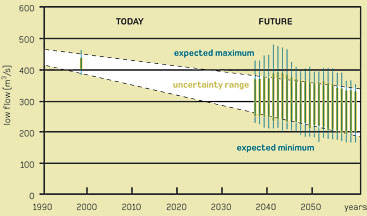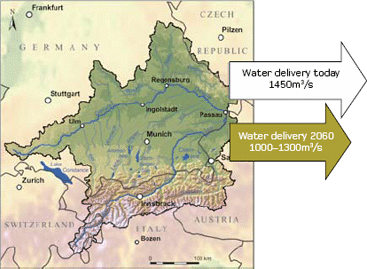The future of water – consequences of climate change in Central Europe

The future of water – consequences of climate change in Central Europe
An integrative research project from Germany is analysing the probable consequences of climate change to develop alternatives for sustainable future watershed management and determine the future of water resources.

The view from the Walhalla near Regensburg on the Danube. The Upper Danube watershed with its current water surplus serves the large downstream regions of the Danube with water supplied for transportation, irrigation, hydropower generation and industrial water use.
Climate change will alter the water cycle in Central Europe and force water resource managers to adapt. Higher regional risks of droughts and floods, the retreat of glaciers and snow cover in the Alps as well as changes in the natural and agrarian vegetation will be likely consequences of climate change. GLOWA-Danube is an integrative research project analysing possible futures of the water resources in the Upper Danube.
GLOWA-Danube was launched in 2001 as part of the GLOWA- (Global Change of the Water Cycle) -initiative of the German Federal Ministry for Education and Research. The project focuses on the Upper Danube Basin (77,000 km2), which consists of a mountainous region in the Alps and its forelands
The role of the Upper Danube Basin. The water resources of the Upper Danube watershed, though currently plentiful, are used intensively by agriculture, industry and households. A broad palette of hydraulic structures like reservoirs, dams, hydropower structures and water transfers are already operational in the watershed to optimise water use for the current hydrologic situation.
“Because of its large altitudinal gradient of up to 3,600 m, the Upper Danube watershed will be most sensitive to the expected climate change,” says Wolfram Mauser, project leader of GLOWA-Danube. A changing water cycle will most likely affect tourism, hydropower production, agriculture, industry and households through a change in seasonal water availability.
The Upper Danube watershed with its current water surplus serves the large downstream regions of the Danube with water supplied for transportation, irrigation, hydropower generation and industrial water use. “Any change in the water availability in the Upper Danube will therefore affect the large and developing population in the downstream Eastern European EUcountries,” says Mauser.

Investigating the impacts of climate change. As part of the interdisciplinary GLOWA-Danube project, researchers from natural and socio-economic sciences are collaborating to investigate the regional impact of climate change on water resources, energy production, agriculture, water use (domestic and industry) and tourism to identify and simulate effective and efficient regional strategies to adapt.
For this purpose the decision support system DANUBIA was developed. It is a coupled and transferable simulation tool that combines climate and natural sciences, socio-economic sciences as well as their interactions in a novel way. “DANUBIA is being applied to simulate the impacts of complex future scenarios like climate change, changing demography, life styles and land use,” says Mauser.
Over 150 key stakeholders (decision makers from policy, economy and administration) in the watershed discuss the findings to develop and evaluate decision alternatives for a sustainable future watershed management. At the end of the project in October 2010 DANUBIA will be made available as ‘open source’ and will particularly serve decision makers as a tool for a foresighted planning of water resources against the background of global change.
A clear picture of future water resources. The simulation results from an ensemble of 18 regional climate scenarios based on a thorough analysis of IPCC findings, regional climate models and historical climate data of the region covering the uncertainty of climate change in the watershed for the first time give a quantitative view on probable regional climate change impacts in the Upper Danube Basin. “Generally, water in the Upper Danube will become scarcer but will not be scarce until 2060,” says Mauser.
The reduced water availability results from complex interactions of a slight decrease in annual precipitation (-3.5% to -16.4%) with future temperature (+3.3°C to +5.2°C) and evapotranspiration increases (+10% to +25%). “This will increase yields for farmers in the watershed,” Prof. Dabbert, the agricultural economist in the project says.
Additionally the simulations show that decreasing snowfall and snowmelt will cause a shift of peak flow from summer to spring and will strongly reduce low flows by -25% to -53% and will further restrict navigation. As a consequence, shrinking water availability will reduce hydropower production by 10% to -16% and increasing water temperature will more frequently limit the cooling capacities of thermal power plants.

Reduced water availability will result from of a combination of a slight decrease in annual precipitation with future temperature and evapotranspiration increases.
Impact on downstream countries. These changes will also affect tourism in the watershed: winter tourism in the low-lying skiing resorts will vanish whereas high-altitude resorts may profit. Based on the mentioned scenario simulations, water delivery to downstream countries, which depend on Upper Danube water, will decrease moderately to significantly until 2060 by -5% to -35%.
“The synopsis of the results calls for a re-evaluation of
the role of the Upper Danube as the European ‘water
tower’ considering the impacts of climate change as
well as new water transfer options,” says Mauser.
For more information, please visit: www.glowa-danube.de






